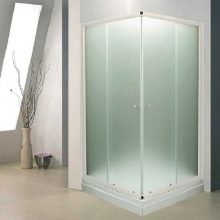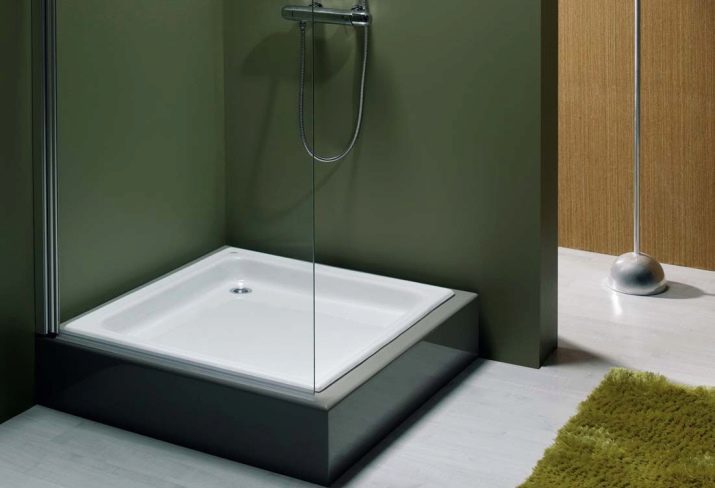Shower enclosures are the optimal solution for small bathrooms, if you need to achieve ergonomics and functionality. Consider the features of this design with a low pallet.
Design features, advantages and disadvantages
A feature of the shower enclosure is its compactness and ergonomics. This design is adjacent to the walls of the bathroom, that is, the walls of the room simultaneously serve as the walls of the shower enclosure. For convenience, the latter is usually located in one of the corners of the bathroom, although it can simply lie against the wall.
Unlike shower boxing, shower corner has fewer walls, does not have a ceiling. Design features are one of the advantages of the corner - it can even be placed in a small bathroom.




The shower enclosure can have many shapes and sizes.Therefore, it will be possible to “fit” it even into small niches, premises of complex shape. As a rule, for a shower corner plumbing is purchased separately. This allows you to choose products that are suitable for the class and, accordingly, price.
However, shower corners, due to their design features, have less functionality compared to closed boxes.
Shower corners can be with a pallet or without it. In most cases, mounting the product with a pallet is easier and less time-consuming compared to installing an analog without a pallet. This is due to the fact that the latter require laying pipes and other communications under the screed. Besides, it is necessary to lay the floor at a certain slope so that the water does not flow around the entire bathroom, but collects in the drain.


Installation of products with a pallet in this respect is simpler - usually you only need to connect the structure to an existing water system. In addition, the sump reduces the risk of flooding.
Depending on the height of the pallet, it can be low, medium and deep. The height of the low pallet is 5-7 cm. It is especially suitable for use by older people, people with disabilities - all those who are physically unable to cross the high pallet. In general, this is a convenient design that does not visually clutter up the room, which sometimes happens when using a high pallet for a corner.
However, if you plan to use a shower corner also for sitting bathtubs, then with a low tray this will be impossible. According to user reviews, such a model is not the best option for families with small children, pets. Unless, of course, there is still a “full” bathtub.


Shape and size
The shape of the booth is determined by the shape of its pallet. The most popular forms of a shower enclosure are a triangle or its smoother version - 1/4 of a circle. Also “running” are a cubicle-square and a rectangle. If the dimensions of the bathroom allow, then it can be a pallet in the shape of a semicircle, then the corner adjoins one of the walls. For bathrooms lined with furniture or complex in shape, you can choose a pallet in the form of a trapezoid or other asymmetric shape.
The standard sizes for a shower corner are considered 90x90, 100x100, 1100x1100 and 120x120 cm. Of course, there are more compact models - 80x80, 85x85 cm, but using them is not so comfortable. Visually, such cabins look like an isosceles triangle.
If we are talking about products of a rectangular shape, then often there are pallets in the dimensions 80x100, 80x120, 100x80, 100x90, 110x80, 120x80, 120x90 cm. In this case, the length of the booth is indicated first, then the width. That is, a product measuring 120x90 cm is not the same as a 90x120 cm pallet.



Material
When it comes to material for shower enclosures with a tray, this refers to the material of the walls and the tray itself.
Walls and corner doors can be made of plastic and glass. Plastic structures have less weight and cost, but they are less durable - they lose their original geometric shape over time. In addition, plastic is difficult to maintain - after a short period of operation, traces and soap scuffers appear on the plastic surface.
Glass, despite the apparent fragility, is a more reliable and durable option. The fact is that for the production of a corner they use a special durable glass with a thickness of at least 4 mm. There is also a variant of tempered glass products, the thickness of which reaches 6 mm.



Finally, you can choose highly reliable glass - triplex. It is made on the principle of automotive glass - 2 layers of glass with a transparent reinforcing film laid between them. The thickness of the material can reach 8 mm. It is resistant to mechanical damage, and even in the event of a breakdown, such glass will not shatter into hundreds of wounding fragments, but will remain on the film.
The glass is environmentally friendly, does not lose its shape, and thanks to a special coating, water smudges and soap deposits are easily removed from it.
Glass booths can be transparent or colored, smooth or matte. In most cases, the choice in favor of one or another option is made based on the personal preferences of the owner.
However, it is worth remembering that if scratches appear on a smooth glass, it will not be possible to polish it. But in the case of a matte product, it can be done.



Acrylic
Let's move on to the possible material options for the pallet.
Cast iron
It is characterized by strength, durability (operating life reaches 50 years), but has a lot of weight, which can cause difficulties with transportation and installation. In some older houses, a cast-iron pallet may require additional floor reinforcement. However, again, due to the large weight, the sump does not vibrate and does not deform, does not make noise during water collection.
Cast iron pallets usually do not have a wide variety of shapes, which is associated with the complexity of giving the product the desired configuration. As a rule, these are triangular, square and rectangular models.
The material has low thermal conductivity, so the water in such a tray cools slowly. In general, reliable and high-quality, but quite expensive option.

Steel
Steel pallets are usually coated with enamel, which gives them an external appeal, strength and increases the service life. Such products have a wide range of shapes and sizes. However, due to the low density of the material, it often deforms, vibrates and makes noise when water is drawn. A steel pallet is not the best option for overweight people.
Besides, the product holds heat worse compared to the cast iron counterpart. If an object falls into the pallet, cracks may appear on the enamel surface.
In this case, it is recommended to replace the product with a new one.

Acrylic
One of the most popular materials. This is due to its high quality, long (up to 25 years) service life, attractive appearance, hygiene and affordability.
Acrylic is a plastic material at the production stage, so pallets can have the most diverse, even complex asymmetric shape. In addition, they can have various shades and sizes. Casting acrylic should be preferred. It is more reliable and durable than that produced by extrusion. Sometimes an acrylic tray is given a plastic bowl, covered with an acrylic layer from the inside. However, such a product has a service life of no more than 10-12 years, is deformed, afraid of temperature extremes.
Another type of acrylic is kvaril. This is the same acrylic, but with the addition of quartz sand. Due to this, the material becomes more durable and durable.


Ceramics
Such a pallet is very attractive in appearance. Due to a sufficiently large weight, it will be stable, will not deform. However, at the same time ceramics are a fragile material, even dropping a small object can cause damage to the pallet. In this case, it becomes impossible to use it, a replacement is necessary.

A rock
Usually they mean artificial stone. Natural is not used due to its high weight, processing complexity, surface porosity (unhygienic) and the presence of radiation background. Artificial stone is a composite material that is stylized as a natural stone surface. It is, of course, lighter than the natural counterpart, but still has a lot of weight.
The pallet can be made in any form, it always looks stylish and respectable.


How to choose?
When choosing a corner, you need to consider the size of the bathroom. The dimensions and shape of the structure depend on this. In small rooms it is convenient to place corner models with a pallet in the shape of 1/4 circle or square. For a narrow long bathroom, a rectangular design will also be a good option.



When choosing an angular booth, you need to immediately determine which corner it will be located in. In accordance with this, right- or left-handed models are selected.
Preference should be given to glass models. If this is a frame product, it is better if it has a metal frame. As for guides and other elements, the metal option is always preferable.

For small bathrooms, cabins with sliding doors are often recommended. When buying this option, make sure that the guides are made of metal, have magnets and rubber pads. Only in this case can the integrity of the structure and its long service life be guaranteed.
If you choose a model with a hinged door, make sure that when opening it does not close the passage or cause other inconveniences.
For reasons of economy, many prefer one-door booths.This is a suitable option, provided that the doorway has a sufficient width (at least 50 cm).



Market leaders are products from Italy, Germany, France. However, they have a rather high cost. They are not inferior to them in quality, but are much lower than corners from the Czech Republic and Finland.

See below for how to choose a shower enclosure.










